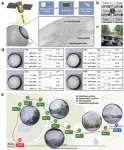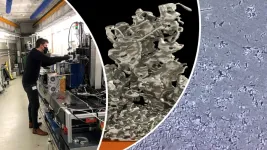(Press-News.org) With the advent of the Metaverse era, there have been growing expectations that virtual reality (VR) and augmented reality (AR) technologies will likely to enhance convenience in everyday life, as well as industry productivity performance.
A joint research team, affiliated with UNIST has introduced core technology for smart contact lenses that can implement AR-based navigation through a 3D printing process. According to the research team, the new smart contact lenses can be worn inside the eye of a person, like a normal contact lens.
Published in the February 2023 issue of Advanced Science, this breakthrough has been jointly led by Professor Im Doo Jung in the Department of Mechanical Engineering at UNIST and Dr. Seung Kwon Seol from the Smart 3D Printing Research Team at Korea Electrotechnology Research Institute (KERI).
Some of the disadvantages of existing AR devices include high price, experimental technology, and bulky appearance, making them difficult to get access to the market. Smart contact lenses, on the other hand, have the advantages of being affordable and convenient, as it can be worn inside the eye of a person. Leading companies throughout the world, such as Google are currently working on creating smart contact lenses, capable of implementing AR. Still, there exists barriers that impede the effective and efficient commercialization of research due to severe technical challenges.
In implementing AR with smart contact lenses, energy-saving electrochromic (EC) displays that can be driven with low power are suitable. Prussian blue (PB) has been regarded as one of the attractive EC material due to its uniform coloration, fast kinetics, high optical contrast, multiple color states (blue, white, green), environmental friendliness, and cost competitiveness. However, this method has limitations in displaying words or images that are needed for a display on AR smart contact lenses because of the difficulty of micro-patterning PB on the contact lens, noted the research team.
The joint research team studied how to not use an electroplating process, and as a result, they developed simple and effective printing strategy to produce micro-patterns of PB using the meniscus-guided printing of an acidic-ferric-ferricyanide ink composed of FeCl3, K3Fe(CN)6, and HCl. The key to this is the meniscus of the acidic-ferric-ferricyanide ink.
As with the conventional electroplating approach, the substrate used must be a conductor when voltage is applied. However, with the meniscus phenomenon, there is no restriction on the substrate that can be used because crystallization occurs by natural evaporation of the solvent. Our micro-pattern technology is very fine (7.2 micrometers) that can be applied to smart contact lens displays for AR, and the color is continuous and uniform.
The role of smart contact lens is most anticipated in fields, like navigation. Through experiments, researchers successfully demonstrated PB-based EC displays in a smart contact lens with a navigation function. The device was able to display directions to the destination to the user on the EC display by receiving GPS coordinates in real time, noted the research team.
“Although thin glass ITO was used for the EC display in this study, it can be further developed as a method of patterning transparent electrodes, such as graphene on flexible materials and printing EC materials,” noted the research team. “We believe that our novel strategy will serve as an attractive method for realizing PB-based EC displays as well as diverse functional devices with micro PB patterns.”
In recognition of its excellence, the related research results have been featured as the back cover of Advanced Science (IF 17.521/JCR 4.71%), a world-renowned academic journal in the field of materials science.
Journal Reference
Je Hyeong Kim, Seobin Park, Jinhyuck Ahn, et al., “Meniscus-Guided Micro-Printing of Prussian Blue for Smart Electrochromic Display,” Advanced Science (2023).
END
Researchers unveil smart contact lens, capable of implementing AR-based navigation
2023-03-09
ELSE PRESS RELEASES FROM THIS DATE:
3D battery imaging reveals the secret real-time life of lithium metal cells
2023-03-09
Innovative battery researchers have cracked the code to creating real-time 3D images of the promising but temperamental lithium metal battery as it cycles. A team from Chalmers University of Technology, Sweden, have succeeded in observing how the lithium metal in the cell behaves as it charges and discharges.
The new method may contribute to batteries with higher capacity and increased safety in our future cars and devices.
“We’ve opened a new window in order to understand – and in the long term to optimise – the lithium metal batteries of the future. When we can study exactly what happens to the lithium in ...
Naturally occurring peptide may tackle the ‘root cause’ of obesity-related conditions
2023-03-09
Research published today shows that a peptide (small protein) called PEPITEM could provide a revolutionary approach to reducing the risk of type 2 diabetes and other obesity-related diseases such as hepatic steatosis (fatty liver).
The researchers used an animal model of obesity to investigate whether PEPITEM, delivered by a slow-release pump, could prevent or reverse the effects that a high fat diet has on the pancreas. Excitingly, the results showed that administration of PEPITEM significantly reduced the enlargement of insulin-producing cells in the pancreas and ...
C-reactive protein reduces the immune response in inflammatory disease
2023-03-09
The biological function of the C-reactive protein, CRP, has long been unknown. Researchers at Linköping University in Sweden now show that this protein has a beneficial function in systemic lupus erythematosus, SLE, an inflammatory disease. But this is true only for one of CRP’s two forms, according to the study published in Journal of Autoimmunity.
Most of us have had a CRP blood test on more than one occasion. This is a very common routine health care test used to detect infection or systemic inflammation in the body. What is measured is the level of C-reactive protein, or CRP for short.
“CRP ...
Study: Higher fracture risk after total hip replacement when cementless implant used to treat femoral neck fracture
2023-03-09
A study by Hospital for Special Surgery (HSS) and other centers found that total hip replacement performed with a cementless prosthesis for a femoral neck fracture led to a higher rate of a second fracture and subsequent revision surgery. The research was presented today at the American Academy of Orthopaedic Surgeons (AAOS) Annual Meeting in Las Vegas. The results were also published online in The Journal of Arthroplasty in October 2022.
Treatments for a femoral neck fracture range from nonoperative management to total hip replacement. When hip replacement is the best treatment option, it can be performed with or without bone cement to secure the prosthesis.
“Femoral ...
Mass General researchers discover the role of intestinal fibrosis in inflammatory bowel disease
2023-03-09
Intestinal fibrosis is a common feature of inflammatory bowel disease (IBD) and the primary cause of end-stage organ failure. Traditionally considered a bystander of inflammation, with negligible involvement in disease pathogenesis, new research published in Gastroenterology now shows that fibrosis has a direct bearing on disease progression in IBD.
The investigation was spearheaded by Nima Saeidi, PhD, Associate Professor of Surgery at the Massachusetts General Hospital (MGH) and Harvard Medical School, along with co-first authors, Shijie He, PhD, and Peng Lei, PhD.
The critical question posed by the investigators ...
Digital rectal examination is not useful to early detect prostate cancers
2023-03-09
A common method of detecting prostate cancer may not be accurate enough as a reliable screening tool by itself, scientists have warned.
The digital rectal exam (DRE) is widely used by medical professionals to check the prostate gland with a finger for unusual swelling or lumps in the rectum as an initial check for the signs of prostate cancer in men.
In some countries, such as Germany, it is the sole method used in a national screening programme for the disease.
But new research by scientists of the PROBASE trial coordinated at the German Cancer Research Center (Deutsches Krebsforschungszentrum, DKFZ) ...
Long Covid is much less likely after omicron than after variant circulating at start of COVID-19 pandemic
2023-03-09
**Note: the release below is a special early release from the European Congress of Clinical Microbiology & Infectious Diseases (ECCMID 2023, Copenhagen, 15-18 April). Please credit the conference if you use this story**
Embargo: 2301H UK time Wednesday 8 March
The omicron variant of SARS-CoV-2 is much less likely to lead to long Covid than the variant circulating at the start of the COVID-19 pandemic, new research being presented at this year's European Congress of Clinical Microbiology & Infectious Diseases (ECCMID 2023, Copenhagen, 15-18 April) suggests.
The Swiss study found that healthcare ...
World’s most comprehensive study on COVID-19 mental health
2023-03-09
COVID-19 has taken a relatively limited toll on the mental health of most people around the globe, according to a paper published today in the BMJ by a McGill University-led research team involving collaborators from McMaster University, the University of Toronto, and other institutions.
The team reviewed data from 137 studies in various languages involving 134 cohorts of people from around the world. Most of the studies were from high or middle-income countries, and about 75% of participants were adults and 25% were children and adolescents between the ages of 10-19.
To their surprise, the researchers found that despite the dramatic stories to the contrary, where ...
Low dose radiation linked to increased lifetime risk of heart disease
2023-03-09
Exposure to low doses of ionising radiation is associated with a modestly increased excess risk of heart disease, finds an analysis of the latest evidence published by The BMJ today.
The researchers say these findings “have implications for patients who undergo radiation exposure as part of their medical care, as well as policy makers involved in managing radiation risks to radiation workers and the public.”
And a linked editorial suggests that these risks “should now be carefully considered in protection ...
Study suggests little deterioration in mental health linked to the pandemic
2023-03-09
Mental health among the general population has not changed by large amounts during the covid-19 pandemic compared with pre-pandemic levels, finds a study published by The BMJ today.
Some specific groups, particularly women, appear to have been more negatively affected, but changes have been minimal to small, say the researchers.
Many studies and media reports suggest that covid-19 has led to widespread decline in mental health, but inconsistencies in study quality and misinterpretation of cross-sectional data may ...




